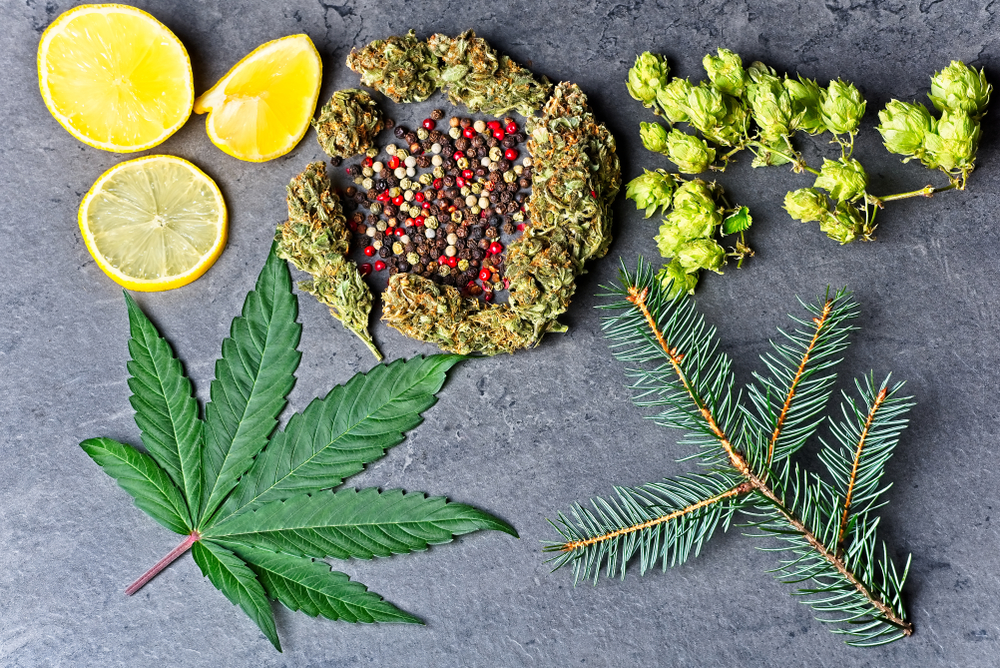An In-Depth Look into Cannabis Terpenes
At this point, most of us are familiar with the concept of cannabinoids and the way in which they work with the body’s endocannabinoid system. The hemp market is at an all-time high, specifically cannabidiol (CBD). However, other hemp-based cannabinoids are showing to be extremely sought-after, including cannabigerol (CBG), delta-8 tetrahydrocannabinol (delta-8 THC), and many more. But, the flowering buds of the hemp plant offer hundreds of individual compounds, and not all of them are cannabinoids. Another class of compounds found in hemp offers significant value to the human system as well called “terpenes” or “Cannabis Terpenes”.
Terpenes can be viewed as cannabinoids’ supporting players, offering properties to the body that both add to the effects of hemp while working synergistically with cannabinoids to ensure a more balanced, well-rounded, and overall effective experience.
What are Terpenes?
Within the hemp plant, we find around 200 terpenes that can be configured in various ways depending on the strain (more on that later). Terpenes are naturally occurring compounds that are found throughout cannabis, but they’re not exclusive to the genus like cannabinoids. In fact, all plant life has terpenes, as they serve a critical function in the wellbeing of a plant.
Terpenes are essentially compounds that we already consume all the time. They are in all plant life, which means that we eat them when consuming vegetables, fruits, and herbs, and terpenes also give essential oils their properties. If you’ve ever used tea tree oil on a wound, or lavender oil before bedtime, you have benefited from terpenes whether you were aware of it or not.
Terpenes are rich in properties that can be used to our advantage. In the plant’s life, they serve the primary function of protecting the plant against harm in the form of infestations, disease and the like. They also provide plants with their flavor and aroma, which is why terpenes are responsible for the way in which the hemp plant tastes and smells.
The terpenes found in the hemp plant, as we said, work synergistically with its cannabinoids. What this means is that when cannabinoids and terpenes are taken together, their potential value can be maximized, as the compounds support the efficacy of one another. This is why so many leading cannabis experts advise users to consume the entire plant’s chemical composition together, which offers something known as the “entourage effect.”
Strains of Hemp: It Comes Down to the Terpenes Profile
Different breeds of hemp have different terpene profiles, referring to how the terpenes are configured. For example, some breeds have higher levels of the terpene myrcene, while others have higher levels of the terpene limonene. The terpene profile, or configuration, found in hemp determines its strain, which is another term used to describe its breed.
You’ve likely noticed that a lot of hemp products come in a variety of strain options, which are determined by their terpene profiles. Because each terpene has its own flavor, aroma and properties, different strains will have different flavors, aromas and potential effects to the body and mind. This is why choosing a strain should be done carefully. There are no undesirable strains out there, but some are more targeted toward specific outcomes than others, such as strains that are more associated with relaxation compared to those that can make you feel happy and energized. Some strains are also capable of helping with pain, sleep, nausea and more.
Another thing to remember is that each strain will have its own flavor profile and aroma. Some strains taste like luscious tropical fruits, with others having a strong skunky smell and taste. Many people choose different strains to explore not only different effects, but different flavors and aromas as well.
There are three categories of strains:
- Indica: Known for being calming, and can help you chill out or even fall asleep more easily
- Sativa: Known for generally being energizing, uplifting and motivating.
- Hybrid: A cross between an indica and a sativa, offering a sort of middle-ground between sativa and indica effects.
Common Terpenes Found in Cannabis
Some of those 200 or so terpenes found in hemp are more prominent in the plant than others, while some exist in such trace levels it’s hard to really analyze their effects. Here are just some of the most popular terpenes found in hemp.
- Caryophyllene: Gives the plant a sweet and spicy taste, while having anti-inflammatory effects and the ability to keep the mind and body calm.
- Myrcene: Determines the type of strain. A hemp strain with more than 0.5% myrcene is an indica, and one with less than that is a sativa. Myrcene is a calming terpene that can help with anxiety, stress and sleep. It’s a terp that is very abundant in mangoes and adds a tropical fruity flavor to the plant.
- Linaloool: Many people are familiar with the effects of linalool since it’s the dominant terpene in lavender. Unsurprisingly, it adds a lavender-like flavor and aroma to the hemp plant when it’s particularly abundant. It’s an incredibly calming terpene that can help a person sleep better, and it offers anti-inflammatory properties as well.
- Pinene: Dominant terp in pine needles, and even gives hemp a pine-like flavor and smell. It’s an uplifting terpene that can give a person feelings of euphoria and may help with depression.
- Limonene: More abundant in sativa strains, and offers a citrusy flavor and aroma. Limonene is also a mood booster, as well as a terpene that can help with nausea and pain.
- Borneol: An antispasmodic that can help with muscle spasms as well as nausea and digestive discomfort. Has a woody and minty flavor.
- Eucalyptol: The dominant terp in eucalyptus, it’s found in hemp as well. It has a woody and minty flavor and aroma that’s really invigorating. Not to mention, give you an increase in energy while offering pain relief and the ability to boost mental focus.
How to Select a Cannabis Strain
Now that you understand the science behind terpenes and strains, you can start choosing a specific strain of a hemp product based on its terpene profile. Terpenes play a really important role in the way in which you experience cannabis, because these compounds are loaded with properties that affect how you feel. To really take advantage of terpenes, make a point to pick a strain of a hemp product that is associated with the properties you’re looking for.
More of today’s hemp products let you select from a large variety of strains, so that customers can really zero in on their goals and find the ultimate strain option for a more customized routine. In fact, you might be surprised by just how much one strain differs from another in terms of the effects that you feel, and how able you are to reach your goals at last.
#1: Avoid CBD Isolate
Know that not all hemp products come in different strains. CBD isolate products don’t have any strain variety since they are terpene-free, containing nothing but cannabidiol extract. The products that most commonly come in different strain options are vaping products and flower, which is just raw hemp buds that can be smoked, vaped or turned into edibles. Note that there are hundreds of different strains out there that you can find in the form of hemp products.
#2: Consider the Three Strain Categories
We explained the differences between indica, sativa and hybrid strains. Each one can differ pretty dramatically in terms of how you feel. So, ask yourself whether you want an indica, sativa or hybrid based on what type of experience you’re looking for.
#3: Do Some Research
View the different strains that are available and choose one that appeals to you by researching it to understand its effects, as well as its flavor and aroma. Finding the perfect strain can take some trial and error, until you end up with the one that really gives you the effects that you’ve been looking for.


